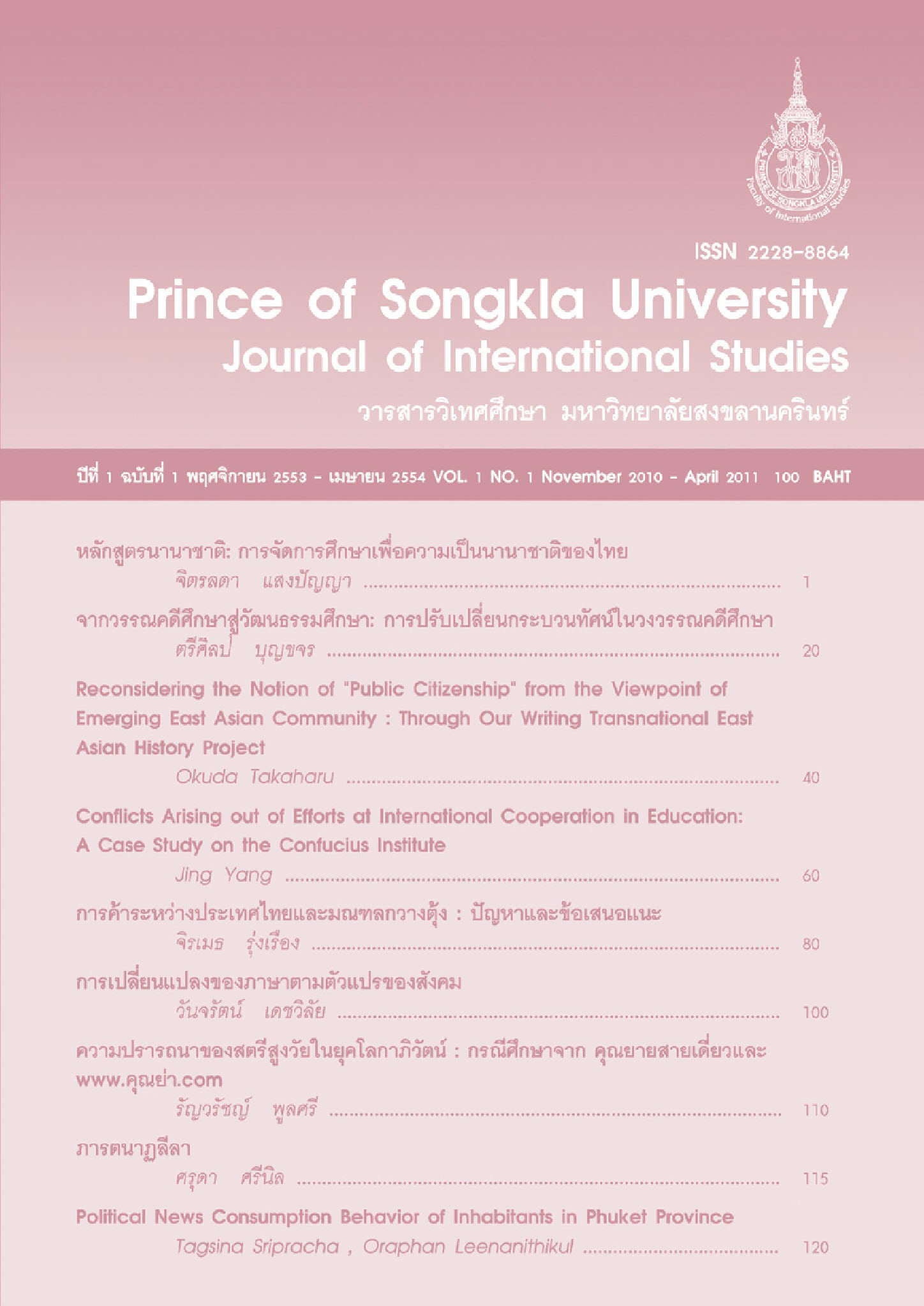Bharata Natayalila
Main Article Content
Abstract
Bharata Natayalila", an academic article related to beliefs in the Hindu faith, shows the relationship between religion and Bharata ways of life from the past to the present. Religion has a critical influence on Bharata life from birth to death. The Lord Shiva, the principal Hindu god, is supposed to be the originator of dance. Dance performances from the early Bharata period worship the god and are performed by women only. These performers are known as "Devadasis". The Lord Shiva revealed 108 dance postures to humans and Bharatamuni recorded these postures in the Bharata Natayasastra scriptures. These scriptures make up the template for all Bharata perfor mances and remain a key influence on the performing arts across south-east Asia, including Thailand. Teaching Thai performing arts takes the Bharata Natayasastra pat tern into account, but is adjusted step by step in order to conform to Thai culture.
Bharata Natayalila requires several important elements from a show; in particular, in expressing the emotions of performers known as "Nava Rasa" that can express the nine feelings associated with Bharata. These emotional components are composed of Bhava, Raga, Tala and Mudra. Bhava refers to emotion. Raga refers to music or musical composition; Tala refers to the rhythms. Mudra refers to non-verbal language focusing on the use of hand gestures. Basic Mudra has 24 gestures, but more than 500 exist. The original Bharata Nataya gestures come in four types: Bharat Natyam, Khathakali, Kathak and Manipuri. Bharat Natyam, the oldest, was a model for performances in later periods. The objective of all performances is to praise the respective Hindu gods.
Article Details
Statements and opinions expressed in articles herein are those of the authors and do not necessarily reflect the position of the editors or publisher.
Article, information, text, image, etc. which are published in Journal of International Studies, belong to Journal of International Studies. If anybody or any organization would like to use part or whole of them, they must receive written permission from Journal of International Studies before usage.
References
การแสดงกลัก และภารตนาฏยัมของอินเดีย (ม.ป.ป.). (ออนไลน์) เข้าถึงได้จาก: http://www.dances.iloveindia.com (วันที่ค้นข้อมูล : 1 กันยายน 2553)
กัญญรัตน์ จิราสวัสดิ์ (2552), ล่าขุมทรัพย์สุดขอบฟ้าในอินเดีย, กรุงเทพ ฯ : H.N. Group
นาฏศิลป์อินเดีย(ม.ป.ป.).(ออนไลน์) เข้าถึงได้จาก:http://artindia.net-Indian (วันที่ค้นข้อมูล : 10 สิงหาคม 2553)
นาฏศิลป์อินเดีย(ม.ป.ป.).(ออนไลน์) เข้าถึงได้จาก:http://th.wikipedia.org (วันที่ค้นข้อมูล : 2 กันยายน 2553)
นาฏศิลป์อินเดีย (ม.ป.ป.).(ออนไลน์) เข้าถึงได้จาก:http://webhost.tsu.ac.th (วันที่ค้นข้อมูล : 2 กันยายน 2553)
นิยะดา สาริกภูติ (2515), ความสัมพันธ์ระหว่างละครไทยกับละครภารตะ วิทยานิพนธ์อักษรศาสตร์มหาบัณฑิต กรุงเทพ ฯ : จุฬาลงกรณ์มหาวิทยาลัย
พระมหาประมวล ฐานทัตโต (2548), พาราณสี คือ อินเดียแท้, กรุงเทพ ฯ : ร่มธรรม.
มาลินี ดิลกวณิช. (2543), ระบําและละครในเอเชีย, กรุงเทพ ฯ : โรงพิมพ์มหาวิทยาลัยธรรมศาสตร์
สมเด็จพระเจ้าบรมวงศ์เธอ กรมพระยาดํารงราชานุภาพ. (2546), ละครฟ้อนรํา กรุงเทพฯ : บริษัทพิฆเณศ พริ้นท์ติ้ง เซ็นเตอร์,
สิริรัตน์ ประพัฒน์ทอง (2536), การศึกษาเครื่องดนตรีจากหลักฐานทางประวัติศาสตร์และโบราณคดี ที่พบในประเทศไทยก่อนพุทธศตวรรษที่ 16.กรุงเทพฯ : มหาวิทยาลัยศิลปากร
อรุณ เฉตตีย์. (2539), อินเดีย แผ่นดินถิ่นมหัศจรรย์, กรุงเทพ ฯ : โรงพิมพ์ มหาวิทยาลัยธรรมศาสตร์
Bolland, David (1980). A Guide to Kathakali . New Delhi.
Devi, Ragini (2002). Dance Dialects of India. New Delhi.
Khokar, Ashish Mohan (2004). Classical Dance. New Delhi.


